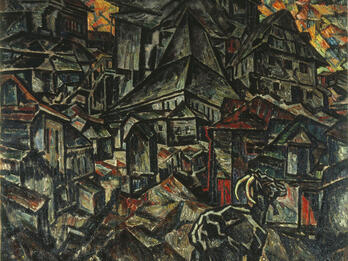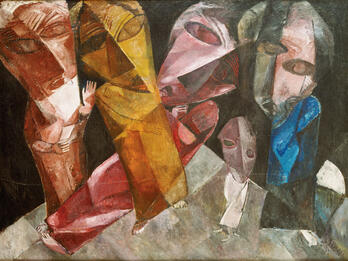The Prophet
Ludwig Meidner
1919
Image

Engage with this Source
Creator Bio
Ludwig Meidner
1884–1966
The expressionist painter and printmaker Ludwig Meidner was born in Silesia and studied art in Breslau (today, Wrocław, Poland) and Paris. He was a radical exponent of expressionism and a champion of pacifism and socialism. From 1912, he produced a series of “apocalyptic landscapes” envisioning the catastrophic collapse of the German city that eerily presaged later events and, after World War I, a series of portraits of prophets. In 1939, he and his artist wife, Else, fled to England, where he was interned for a time on the Isle of Man as an enemy alien. Unrecognized in Britain, he returned to Germany in 1953, while his wife remained in London.
Restricted
Image
Places:
Berlin, Weimar Republic (Berlin, Germany)
You may also like

Destruction of the Ghetto
In 1919, during a civil war raging in Ukraine, a wave of pogroms swept the area around Kiev. In one of them, Manievich’s son was killed, and this painting expresses his grief. The destroyed homes and…

Eternal Wanderers
At first Eternal Wanderers seems like an abstract assemblage of colorful shapes. A closer look, however, reveals a group of people, young and old, with mask-like faces, teetering on tilting ground…

Sabbath
Weber was one of the few American modernists to paint religious subjects. He painted Sabbath around the time he became associated with a group of American Yiddish writers called Di yunge (The Young…

Shtetl
This woodcut was published in Petrograd (Saint Petersburg) after Aronson had left the Soviet Union. In it, Aronson combined elements of cubo-futurism and constructivism. Several figures can be spotted…

The Shohet (from “Had Gadya”)
The violence of the Passover song “Had Gadya” (“Who Knows One”) clearly spoke to this illustrator’s sense of horror following World War I.

Ghetto Theatre
Before World War I, Bomberg depicted the East End of London, where he had grown up, as a site of immigrant vitality. After a harrowing experience in the trenches and difficulties after the war…

